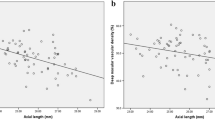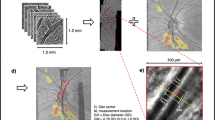Abstract
Purpose
To investigate changes in retinal vessel diameter and blood velocity in high myopia using laser Doppler velocimetry.
Methods
Thirty-nine subjects (39 eyes) were enrolled in the study. The subjects were divided into three groups according to their refractive status; 15 eyes (15 patients) with emmetropia (within ±3.0 diopters), 14 eyes (14 patients) with mild myopia (between −3.0 and −8.0 diopters), and 10 eyes (10 patients) with high myopia (>−8.0 diopters). Patient age was matched between groups. Blood velocity and vessel diameter of the upper or lower temporal retinal artery were measured using laser Doppler velocimetry with an eye-tracking system, and measurements were compared between groups.
Results
The average retinal blood flow and vessel diameter in highly myopic eyes were significantly decreased compared with emmetropic eyes or mild myopic eyes (Mann-Whitney U test, p<0.05). Also, there was significant difference regarding retinal blood flow and vessel diameter between eyes with mild myopia and the other groups. In addition, there was no significant difference in blood velocity between the three groups.
Conclusions
Retinal blood flow was decreased in high myopia, mainly due to the narrowing of the retinal vessel diameter. Impaired retinal blood flow might have a role in the development of chorioretinal atrophy in high myopia.



Similar content being viewed by others
References
Akyol N, Kukner AS, Ozdemir T, Esmerligil S (1996) Choroidal and retinal blood flow changes in degenerative myopia. Can J Ophthalmol 3:113–119
Avetisov ES, Savitzkaya NF (1977) Some features in ocular microcirculation in myopia. Ann Ophthalmol 9:1261–1264
Avila MP, Weiter JJ, Jalkh AE et al. (1984) Natural history of choroidal neovascularization in high myopia. Ophthalmology 91:1573–1581
Curtin BJ (1985) The myopias: basic science and clinical management. Harper and Row, Philadelphia, pp 237–245
Feke GT, Riva CE (1978) Laser Doppler measurements of blood velocity in human retinal vessels. J Opt Soc Am 68:526–531
Galassi F, Sodi A, Ucci F et al. (1998) Ocular haemodynamics in glaucoma associated with high myopia. Int Ophthalmol 22:299–305
Ghafour IM, Allan D, Foulds WS (1983) Common causes of blindness and visual handicap in the west of Scotland. Br J Ophthalmol 67:209–213
Grunwald JE, Riva CE, Brucker AJ, Sinclair SH, Petrig BL (1986) Effect of panretinal photocoagulation on retinal blood flow in proliferative diabetic retinopathy. Ophthalmology 93:590–595
Guan K, Hudson C, Flanagan JG (2003) Variability and repeatability of retinal blood flow measurements using the Canon laser blood flowmeter. Microvas Res 65:145–161
James CB, Trew DR, Clark K, Smith SE (1991) Factors influencing the ocular pulse-axial length. Graefe’s Arch Clin Exp Ophthalmol 229:341–344
Mayama C, Suzuki Y, Araie M et al. (2003) Myopia and advanced-stage open-angle glaucoma. Ophthalmology 109:2072–2077
Podos SM, Becker B, Morton WR (1966) High myopia and primary open-angle glaucoma. Am J Ophthalmol 62:1039–1043
Ravalico G, Pastori G, Croce M et al. (1997) Pulsatile ocular blood flow variations with axial length and refractive error. Ophthalmologica 211:271–273
Riva CE, Feke GT, Eberli B, Benary V (1979) Bidirectional LDV system for absolute measurement of blood speed in retinal vessels. Appl Opt 18:2301–2306
Riva CE, Grunwald JE, Sinclair SH, O’Keefe K (1981) Fundus camera-based retinal LDV. Appl Opt 20:117–120
Riva CE, Petrig BL (1990) Retinal blood flow: laser Doppler velocimetry and blue field stimulation technique—noninvasive diagnostic techniques in ophthalmology. Springer, Berlin Heidelberg New York, p 390
Shih YF, Fitzgerald MEC, Norton TT et al. (1993) Reduction in choroidal blood flow occurs in chicks wearing goggles that induce eye growth toward myopia. Curr Eye Res 12:219–227
Sperduto RD, Seigel D, Roberts J, Rowland M (1983) Prevalence of myopia in the United States. Arch Ophthalmol 101:405–407
Sullivan PM, Davies GE, Caldwell G, Morris AC, Kohner EM (1990) Retinal blood flow during hyperglycemia: a laser Doppler velocimetry study. Invest Ophthalmol Vis Sci 31:2041–2045
Tanaka S (1997) Eye fundus blood flow meter. USP 5:963
Tokoro T (1998) Atlas of posterior fundus changes in pathologic myopia. Springer, Berlin Heidelberg New York, pp 1–2
Tokoro T (1988) On the definition of pathologic myopia in group studies. Acta Ophthalmol 66:107–108
Yoshida A, Feke GT, Mori F et al. (2003) Reproducibility and clinical application of a newly developed stabilized retinal laser Doppler instrument. Am J Ophthalmol 135:356–361
Yoshida A, Ogasawara H, Fujio N et al. (1998) Comparison of short- and long-term effects of betaxolol and timolol on human retinal circulation. Eye 12:848–853
Yoshida M, Okada E, Mizuki N et al. (2001) Age-specific prevalence of open-angle glaucoma and its relationship to refraction among more than 60,000 asymptomatic Japanese subjects. J Clin Epidemiol 54:1151–1158
Acknowledgement
This work was supported in part by research grant 14571659 from the Japanese Ministry of Education, Culture, Sports, Science and Technology
Author information
Authors and Affiliations
Corresponding author
Rights and permissions
About this article
Cite this article
Shimada, N., Ohno-Matsui, K., Harino, S. et al. Reduction of retinal blood flow in high myopia. Graefe's Arch Clin Exp Ophthalmol 242, 284–288 (2004). https://doi.org/10.1007/s00417-003-0836-0
Received:
Revised:
Accepted:
Published:
Issue Date:
DOI: https://doi.org/10.1007/s00417-003-0836-0




